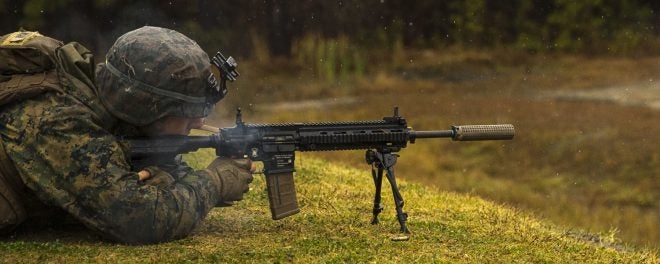The Commandant of the United States Marine Corps (CMC) has stated his approval for an overhaul of the front-line infantry Marine’s gear – including the fielding of the Heckler & Koch M27 Infantry Automatic Rifle as a standard issue rifle, to replace the M4 Carbine. The move comes after considerable debate as to what the USMC’s next infantry weapon configuration should look like. From Military.com’s KitUp!:
In an interview with Military.com in late December, Commandant Gen. Robert Neller confirmed that a decision had been made to move forward with fielding the M27 more widely within the infantry.
Every Marine in an infantry squad, he said, will receive the high-end rifle. And while not every Marine in a grunt battalion will carry the IAR, others outside of the squad will also be issued one.
“I don’t think mortars and javelin guys need the M27,” Neller said. But, he added, artillery forward observers, fire support teams, and even engineers might be good candidates for the weapon.
“I’m going to wait and see,” he said. “It’s not that much [money].”
Neller also asserted his intent to spend money on new equipment for the infantry, as well as for big budget projects like fighters:
The Marines’ new 5th-generation fighter, the F-35B Joint Strike Fighter, costs roughly $100 million per copy, Neller told troops at one of a dozen town hall-style addresses he gave in the span of seven days in late December.
“I could kit out every grunt in the Marine Corps with the coolest s*** head-to-toe for $100 million,” he said. “And I intend to do that.”
Previously on TFB, we discussed that, although the M27 is an effective rifle with better capabilities than the current M4 Carbine used by the USMC, it falls short of being the ideal choice for the Corps. If the USMC does decide to replace the M4 with the M27, then it would be a major missed opportunity if they simply purchased more of the weapons first fielded in 2011. Instead, the Corps should seek out an “M27A1” variant which would improve on the existing weapon. Such a rifle would ideally incorporate a variety of improvements, such as:
- Gas system regulated for standard M855A1 EPR ammunition
- Improved low POI-shift M-LOK rail system for nightfighting using laser aiming devices
- High quality match trigger, preferably with a “gas pedal” style selector lever
- Lighter, shorter barrel for better maneuverability and mobility
- Muzzle device compatible with modern detachable sound suppressor
- 1-8 power ruggedized optical scope
- A true domestic second source provider for the rifles
Each of these improvements would be non-developmental in nature, and would result in a considerably more effective weapon that is more suitable as a standard infantry rifle than the current M27. Even with these improvements, however, the M27 would still carry a number of disadvantages versus an upgraded M4 like those being pursued by SOCOM and the USAF through the URG-I and IMR-Blue programs. First, even an upgraded M27 may experienced reduced bolt life and higher maintenance costs versus an M4 Carbine, due to the nature of its gas system (this subject is expanded upon here). Second, an upgraded M27 would still be significantly heavier – by a pound of more – than a comparably improved M4 Carbine. Third, unless a license-produced second-source contract were negotiated, the M27 would make the USMC beholden to a single provider for all of its combat rifles (therefore it is strongly suggested that they do negotiate a second source). Fourth, the adoption of the M27 would mean the end of commonality between USMC and US Army rifles, which could cause logistical difficulty during operations. Finally, and perhaps most importantly in the big picture, a unified or near-unified upgraded upper receiver group for all three organizations, USMC, SOCOM, and USAF, would put pressure on the Army to do likewise and finally implement “M4A1+” upgrades which have been “common sense” for nearly a decade.
Seck, H. H. (2018, January 5). M27s and ‘Head-to-Toe’ Gear Overhaul on the Way for Marine Grunts. Military.com. Retrieved from https://www.military.com/kitup/2018/01/05/m27s-and-head-toe-gear-overhaul-way-marine-grunts.html
 Your Privacy Choices
Your Privacy Choices
